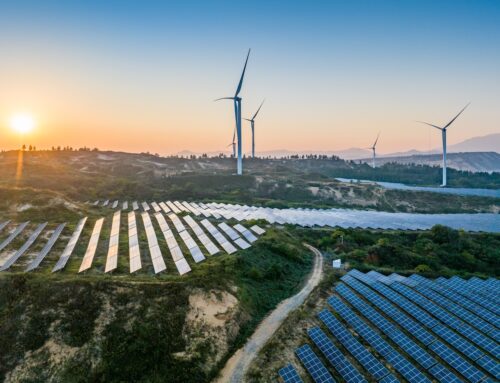Solar Now the World’s Cheapest Energy, Powering the Clean Transition
October 9, 2025
Solar energy has officially claimed the title of the world’s most affordable source of electricity. According to new research from the University of Surrey’s Advanced Technology Institute (ATI), solar power now costs as little as £0.02 per kilowatt-hour in the sunniest regions.
The study, published in Energy and Environmental Materials, highlights how solar photovoltaic (PV) technology has transformed from a niche innovation into the backbone of the global clean energy revolution.
As countries race to cut carbon emissions and combat climate change, the rapidly falling cost of solar power is unlocking access to clean energy on an unprecedented scale.
Solar Becomes the Cornerstone of a Low-Carbon Future
Professor Ravi Silva, co-author of the study and Director of the ATI, emphasized that even in less sunny nations like the UK, solar power has become the most cost-effective option for large-scale generation.
He precisely noted,
“Even here in the UK, a country that sits 50 degrees north of the equator, solar is the cheapest option for large-scale energy generation. Globally, the total amount of solar power installed passed 1.5 terawatts in 2024 – twice as much as in 2020 and enough to power hundreds of millions of homes. Simply put, this technology is no longer a moonshot prospect but a foundational part of the resilient, low-carbon energy future that we all want to bring to reality.”
This milestone shows that solar energy is no longer experimental. It’s a proven cornerstone of the low-carbon future the world is building toward.
Alongside solar, the cost of lithium-ion batteries—key to storing renewable power—has dropped by a staggering 89% since 2010. This sharp decline has made solar-plus-storage systems a competitive alternative to conventional gas-fired power plants.
Global Solar Costs Fall Over 80% in a Decade
According to the International Renewable Energy Agency (IRENA), the global weighted-average levelized cost of electricity (LCOE) for utility-scale solar PV dropped by over 80% between 2010 and 2023. In sun-rich regions, it now costs as little as $0.03 per kilowatt-hour—making it the cheapest source of new electricity generation worldwide.
This steep decline stems from a mix of technological, economic, and policy factors. Breakthroughs in solar cell efficiency, bifacial modules, and tracking systems have dramatically boosted energy output.
China’s Role in Falling Clean Energy Costs
Meanwhile, bigger economies, especially from large-scale manufacturing in China, have lowered hardware and installation costs.
Bloomberg also expects the cost of clean energy technologies, i.e., solar, wind, and battery storage, to drop further in 2025. It could be falling 2–11% and breaking last year’s records. In almost every part of the world, new solar and wind farms are now cheaper to build and operate than new coal or gas plants
Significantly, China’s overcapacity in clean tech has led some countries to impose import tariffs, temporarily slowing cost declines. Still, BNEF expects levelized costs for clean energy to fall 22–49% by 2035, keeping renewables on track for long-term growth.
- Battery storage costs dropped a third in 2024 to $104/MWh, driven by oversupply from slower EV sales, with prices expected to cross $100/MWh in 2025.
- Fixed-axis solar farms fell 21% globally, while wind and solar generation costs are projected to decline another 4% and 2%. It ensures clean energy remains cheaper than fossil fuels.


Storage Revolution: Solar Power Around the Clock
The global energy storage boom has turned solar from an intermittent resource into a 24-hour power solution. It’s because of the massive cost reductions in batteries, solar-plus-storage systems can now compete head-to-head with gas-fired plants.
However, challenges remain in connecting large volumes of solar power to existing grids. Regions like California and China have already experienced energy curtailment due to grid congestion when solar output exceeds demand.
Dr. Ehsan Rezaee, co-author of the University of Surrey study, noted that “smart grids, artificial intelligence forecasting, and stronger regional interconnections will be essential to maintain power system stability as renewable adoption grows.”
Global Policy Boosts vs. U.S. Uncertainty
Supportive policy frameworks are key to sustaining solar’s momentum. In Europe, the Green Deal and RePowerEU initiatives have simplified permitting and set aggressive renewable targets.
India’s Production Linked Incentive (PLI) scheme, meanwhile, is strengthening local solar manufacturing to reduce dependence on imports. These measures are not only cutting carbon emissions but also advancing energy security, job creation, and economic growth.
International partnerships, such as the International Solar Alliance (ISA), continue to drive collaboration, knowledge exchange, and capacity building, particularly in developing nations that stand to benefit most from affordable solar energy.
OBBBA: Dimming the Sunshine
However, the story is slightly different in the U.S. In July 2025, President Trump signed the One Big Beautiful Bill Act (OBBBA), which speeds up the phase-out or early termination of most renewable energy tax credits and clean energy incentives established under the IRA.
As a result, U.S. clean energy incentives are being rapidly scaled back, with many tax credits set to expire or face new restrictions and deadlines, creating significant uncertainty for investors and project developers.
Breakthrough Technologies Drive the Next Wave
Solar technology innovation is accelerating at record speed. Researchers at the University of Sydney recently achieved a world-first breakthrough with a 16 cm² triple-junction perovskite solar cell delivering 23.3% efficiency for large-area devices. A smaller version reached 27.06% efficiency—the highest globally—and retained 95% performance after 400 hours of continuous operation.
Perovskite solar cells could revolutionize the market by boosting energy output by up to 50% without expanding land use. They can be made as thin, flexible films at lower temperatures than traditional silicon panels, cutting production costs significantly. Over the past decade, perovskite efficiency has soared from 3% to over 25%, with tandem cells poised to exceed 30%. These innovations will further drive down solar costs and expand applications across rooftops, vehicles, and portable systems.
Solar Dominates Future Renewable Growth
The International Energy Agency (IEA) forecasts that global renewable capacity will double by 2030—adding 4,600 gigawatts (GW), equivalent to the combined power generation capacity of China, the EU, and Japan.
- Solar PV will account for nearly 80% of this growth, followed by wind, hydropower, and bioenergy.


According to DNV’s latest Energy Transition Outlook, global solar capacity is expected to surpass 3,000 GW by the end of 2025, with China holding 47% and Europe 20%. It further highlights:
- Solar already generates about 10% of the world’s electricity and is projected to reach 20% by 2029 and 40% by 2045.
- Behind-the-meter (BTM) solar used by households and businesses is also on the rise and is expected to make up 30% of total solar generation by 2060.
- Wind power is projected to nearly double to over 2,000 GW by 2030, but solar remains the lowest-cost option in most markets.
India is emerging as the second-fastest renewables market after China, advancing its 2030 targets. Expanded auctions and rapid rooftop solar growth contribute to the solar boom.
However, the world still falls short of the COP28 goal to triple renewable capacity by 2030, achieving about a 2.6-fold increase from 2022 levels. Closing this gap will require continued investment, innovation, and political will.
Building a Resilient Solar Future
As solar continues to dominate the global energy landscape, integration challenges must not be ignored. Expanding transmission networks, deploying digital grid management tools, and investing in advanced materials will be crucial.
Professor Silva emphasizes that sustained policy backing and continued innovation will determine how quickly the world transitions to a clean, resilient energy future.
The Renewable Energy Institute applauds solar’s rise as the cheapest source of electricity and continues to provide accredited training to build the skills needed to sustain this momentum.
Thus, from record-low costs to record-breaking efficiency, solar energy is reshaping the global energy system faster than anyone imagined. Its combination of affordability, scalability, and innovation is driving the clean energy transition forward.
The question now isn’t if solar will dominate, but how quickly the world can harness its full potential.
Search
RECENT PRESS RELEASES
Related Post




